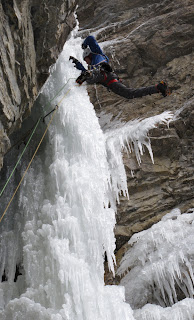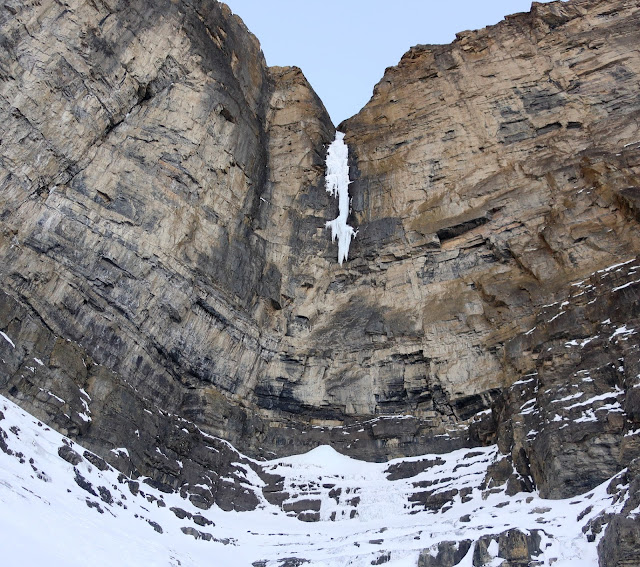"... and keep your heels down!"
A lot of factors contribute to competent ice climbing, such as technique, endurance and boldness. None of these comes easily, at least not to me. But something else that's key to efficient ice climbing is having one's systems dialed - and that's a bit easier to come by. Over the years I've developed my own set of habits that serve me well when venturing out into the cold. They are all rather self-evident, but maybe you will find one or two of them useful. In no particular order:
- For a full ice-climbing day I typically bring three pairs of gloves: thin ones for approaching, a favourite pair for climbing, and thick ones for belaying. That makes for two pairs on the climb. I clip the belay gloves to the back of my harness while climbing and change into them at belays, while the climbing gloves go deep inside my clothes to stay warm for the next pitch.
Count on your approach gloves getting wet.
- If the approach is over an hour or so, I bring a spare pair of socks to change into at the rope-up spot. Dry socks make a big difference to how warm my feet stay while climbing. To make a good thing even better, I pack the spare pair next to a bottle of hot drink; that way they're already preheated when I put them on. If I expect to really sweat on the approach, I bring a spare shirt, too.
Guy Lacelle smiling at the thought of a dry shirt.
- I am very particular about having my boots laced up just right: tightly enough to eliminate any slop, but not so tightly as to cut off circulation. To that end I find it helps to lace up my boots while standing. That way my feet are bearing weight and are in the position they'll be in while climbing.
It doesn't matter how you lace your boots when you won't be using your feet much anyway, like in the Haffner Cave. Photo: Marcus Norman.
- I try to dress so that when wearing all my layers, I get just a bit chilled standing around. That way I don't overheat while climbing. As soon as I get to a belay stance, I put on a parka that I carry in a stuff sack clipped to the back of my harness.
Eamonn Walsh happy as a clam in his belay coat on Rectal Squirrels, Storm Creek. Photo: Pierre Darbellay.
- Climbing in the cold, dry Rockies, I am a big fan of softshell and hardly ever wear Goretex. I find softshell usually breathes better, moves better and looks better. But there are times, on climbs that are running with water or on warm, snowy days, when only Goretex would keep me from getting soaked to the skin (if I had worn it, that is).
Scott Semple wishing he'd worn shell pants on a very wet early-season Sacre Bleu.
- Ice climbing obviously tends to be cold and uncomfortable. But few things come close to the nauseous agony of screaming barfies, as blood rushes back into frozen hands. While getting the barfies once in a while is probably unavoidable, with a bit of discipline they can usually be avoided. I find the key is to keep moving at the inevitable long belays, to prevent the onset of a deep chill. Even so, before I break down the anchor and start seconding the pitch, I spend a minute or two vigorously swinging my arms to rewarm them some more.
"Big Wall" Pete Takeda staying warm on a snowy day on the Trophy Wall.
- Early on in my climbing career I made a concerted effort to learn to place screws with either hand (I'm strongly right handed). These days I rack as many screws on my left side as on my right. Being able to place screws equally well with both hands allows my to take advantage of the best ice, but most importantly it lets me shake out and/or rewarm whichever hand needs it the most.
Placing gear left handed on Sails for Seniors, Mt. Murchison. Photo: Ian Welsted.
- Ice climbing is obviously gear intensive, and having your gear in good shape makes a big difference. I make sure my picks are sharp before each outing (I don't modify my picks other than maybe bevelling the bottom teeth a bit for easier removal). The same goes for crampons (mostly the front and secondary points), and of course screws (the side of a cutoff wheel on a Dremel tools works well for minor repairs). On a long route with much thin ice I carry a small file for minor pick and screw repairs.
Dulling all points on Dirty Love, Mt. Wilson. Photo: Jon Walsh.
- In the last few years I've started climbing with two-handled leashless tools. These work well for steep ice and mixed, but can be awkward to use on low-angled ice, where the steeply drooped pick tends to strike the ice with the top rather than the point. I find swinging from the upper grip makes low-angled climbing more efficient.
Putting prototype Fusions to the test on Comfort Queen, Stanley Headwall. Photo: Ian Welsted.
- Speaking of leashless tools, it's important not to overgrip while hanging from them. I will often open up my hand and stick out my thumb to ensure I am not using any more force than necessary (obviously a firmer grip is needed while swinging).
Shaking some blood back into the fingers on The Replicant, Mt. Rundle. Photo: Jen Olson.
- I've learned to be patient with my tool placements. Sure, when seconding anything goes (such as tenuous hooking), especially if it gets me up the pitch quickly and with minimal effort. But when leading I try to make every placement solid, as if I were soloing. The problem with one bad placement is that it often leads to another bad one, because I am afraid to lean out on the original one. So I take my time and work with each tool placement until I am happy with it.
Obviously tool placements are only as solid as the ice they're in. Pierre Darbellay reaching better ice on the first ascent of Rectal Squirrels, Storm Creek.
- For technique as well as for gear, I find that simpler is usually better. Sure, I might throw in the occasional knee drop, sometimes even without a camera nearby. But 96% of the time a simple sequence of swinging tools with my feet level and leapfrogging tool placements is the way to go.
Knee dropping for the camera on the GBU, North Ghost. Photo: Josh Lavigne.
There you have: take it for what it's worth (likely not much) and have fun on the ice!















that was worth quite a bit, thanks for sharing Raphael.
ReplyDeleteHi Ralph, very well put in words. Glad to see I'm using same systems as you, although I take some more pairs of gloves up a route.
ReplyDeleteGreat tips. Someone last year told me that when swinging arms around to get the heat going...if you push your palms down and thus fingers and hand outward parallel to the ground and outward from your body and then pump your arms up and down from the shoulders like you are an air pump then the blood flows much better...and it seems to work really well.
ReplyDeleteI am glad you found my tricks useful. I will definitely try the warm-up idea with the palms down. Generally when trying to fight off the big chill I simply try to engage as many big muscles as possible, on the principle that big muscles burn more energy and so generate more heat than small ones. Straight-leg swings work (I make sure to hold on to something while at them, especially at a small belay!), as do "bear swings" (bend forward and swings your arms in front of your body).
ReplyDelete